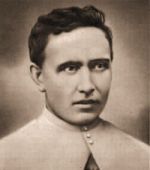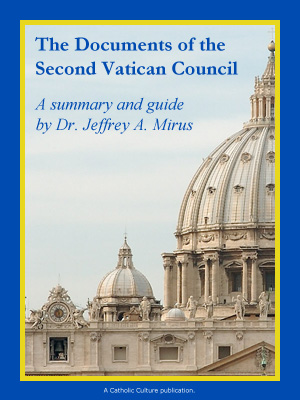St. John Paul II: Top Ten Connections
By Jennifer Gregory Miller ( bio - articles - email ) | Oct 21, 2016 | In The Liturgical Year
 In honor of the feast of St. John Paul II, this is a repost from October 2014 archives:
In honor of the feast of St. John Paul II, this is a repost from October 2014 archives:
Recently my husband and I watched The Roosevelts: An Intimate History by Ken Burns. When the film reached Franklin Delano Roosevelt dying after serving as president of the United States for 12 years, there was a comment that many people couldn’t remember having another president. I have been thinking how this is how I felt when Pope John Paul II died, after he reigned as pope for 25 years (1978-2005). I was eleven at the time of his election, so I can say I “grew up” with John Paul II.
This is the first year of celebrating John Paul II as a canonized saint in heaven. His feast day is an optional memorial for the General Roman Calendar for the universal Church. One of my family’s focal points during the liturgical year is reading and discussing the saint of the day. It can get frustrating at times, since often we only find a short biography, usually just one paragraph, describing the saint. It seems the more distant in history we are to a saint’s life, the less details and information we have. My boys always want more information; they want to know about the person. A short biography doesn’t really capture a person. Highlighting the accomplishments of a life is one-dimensional and more like a résumé than a biography. My sons want to visualize the flesh and blood person; they want childhood stories and anecdotes that make the saint come alive in their minds.
There is no disputing that St. John Paul II’s life’s work is vast, which makes it harder to really fully describe his life. I do find that when we discuss the saints at home, what touches the heart most is the personal connections. I lived during the papacy of John Paul II. He was my Holy Father for 25 years. Like a father he made a great impact on my life, which continues and grows to this day. This is how I will relate this saint to my sons: sharing my Holy Father’s story through my eyes. I was able to see him in person four times, twice in Rome. I’m passing orally how he influenced me. So for this first year as canonized St. John Paul II, I am recalling ten main areas of impact St. John Paul II had on my life.
- John Paul was Polish. At first glance, this doesn’t seem too relevant. After all, we have a pope from Argentina, and the one before him was German. But John P
 aul II was the first non-Italian pope since the 1500s! George Weigel in the beginning of his Witness to Hope explained the significance of having a pope from Poland. Weigel related Polish history, and explained how Poland, unlike other Slavic countries, looks to the West (Rome) for the Liturgy. Understanding a little of Polish culture, tradition, and history, particularly the deep Catholic roots and devotion to Our Lady helps us understand a little of this great pope. The Polish Catholic culture gave John Paul his identity.
aul II was the first non-Italian pope since the 1500s! George Weigel in the beginning of his Witness to Hope explained the significance of having a pope from Poland. Weigel related Polish history, and explained how Poland, unlike other Slavic countries, looks to the West (Rome) for the Liturgy. Understanding a little of Polish culture, tradition, and history, particularly the deep Catholic roots and devotion to Our Lady helps us understand a little of this great pope. The Polish Catholic culture gave John Paul his identity.
And how beautiful it was (and is) to see the Polish pride for their own pope. In 2008 my husband and I attended a family wedding which was held in a little Polish Catholic church. Pope John Paul II had been dead for three years, but the portrait of John Paul II was still hanging up in prominence. This was their pope.
I don’t have Polish roots or connections, but I have enjoyed learning about Polish recipes and traditions over the years. To celebrate our Polish saint, our dinner will be a simply Polish kielbasa and sauerkraut. - Communism—I grew up with the Cold War. My sons didn’t grow up with Russia being called the U.S.S.R. They can’t remember or feel what it was like to pray for the conversion of Russia and the end of communism. They watch the news clips of the Berlin Wall going down and Germany reunited in detachment. It is through my husband and me and our memories and perspectives that our sons can understand the evils of communism and John Paul’s tremendous impact in this area.
John Paul II lived under Nazi and Communist regimes, so he personally experienced firsthand the evils of these philosophies. He was persecuted and suffered physically, but he fought back with the Catholic faith and Polish culture and as pope he continued to fight the evils of communism. I remember reading the news about how John Paul II defied Communist leaders. He was most instrumental in ending communist rule by Russia. - Art and culture —John Paul struggled with the decision between being an actor or a priest. He of course chose the latter, but it didn’t mean the end of his cultivating art, literature, drama, music and culture before and during his papacy. His Letter to Artists and other writings and talks have been influential in directing my work, including my writing, as it cultivates tradition and culture.
- Sunday—The Apostolic Letter Dies Domini (On Keeping Sunday) is so beautiful in understanding the significance of Sunday, a special day, apart from the “weekend.” This letter provides beautiful perspectives on understanding Sunday and the liturgy, but also what it means for the rest of the day, resting and relaxing with family. Our Sundays with family are centered on the “little Easter” and resting in the Lord and relaxing with family—all aspects from his encouragment.
 Devotion to Mary—John Paul II had a tremendous devotion to Our Lady (as illustrated by his coat of arms and motto). This was instilled by his parents and also part of the Polish tradition (as seen in the veneration of Our Lady of Czestochowa). His beautiful encyclical on the rosary, which shared the Mysteries of Light or Luminous Mysteries (I discussed this earlier this month for the Feast of the Rosary), continue to impact us in our daily family prayers.
Devotion to Mary—John Paul II had a tremendous devotion to Our Lady (as illustrated by his coat of arms and motto). This was instilled by his parents and also part of the Polish tradition (as seen in the veneration of Our Lady of Czestochowa). His beautiful encyclical on the rosary, which shared the Mysteries of Light or Luminous Mysteries (I discussed this earlier this month for the Feast of the Rosary), continue to impact us in our daily family prayers.- Apostle of Youth—He used exercise and the love of outdoors (hiking, skiing, etc.) to reach the young people, build community, to spread the faith and to connect with God through nature. This was part of his inspiration for establishing the World Youth Day. I attended two of these events, one in Poland in 1991, and two years later in Denver, Colorado.
- Value of Life—It was inspiring to have such a young pope and his love for the youth. He wrote and spoke and defended life from conception until death, particularly through his encyclical Evangelium Vitae. But John Paul also provided a firsthand example of valuing life in sickness and old age, even when feeble and helpless. He gave such a powerful but silent witness as he suffered publicly from the effects of Parkinson’s disease. This witness has sustained us through miscarriages, surgeries, and heart problems.
- Theology of the Body and Teaching on Women—I am still mining the richness in these areas. One small area that I found especially enlightening was his perspective on modesty. So often People have referred to hard fast rules, but the Church only provides guidelines. This quote from Love and Responsibility really provides a solid criteria on true modesty.
- Duc in altum—John Paul II prepared the faithful from the beginning of his papacy to prepare for the Third Millennium. After we reached the Great Jubilee year celebrating 2000 years since Christ’s birth, he issued the encyclical Novo Millennio Ineunte, in which he meditated on Christ’s words, Duc in altum (Put out in the deep), pointing out that this is the time of the New Evangelization. We follow these words daily when we live and spread the Gospel daily.
- Mercy—He also issued an encyclical on Mercy, Dives in Misericordia (Rich in Mercy) with a focus on the prodigal son and God’s mercy for us. This is also the pope who brought us the Divine Mercy Sunday and the canonization of St. Faustina. We live in a litigious world where we want to exact justice, this pope reminded us that while God is all-just, He also is all-merciful. We must turn to our Father for His mercy, and we also must practice this same mercy with others. This is something I keep I mind every day with my sins and dealing with family and friends.
And above all this, I treasure his first words after his election, “Be Not Afraid!” Those words summarize his entire life, and call us to do the same!
St. John Paul is nicknamed “the Great” because he did so much! It was difficult to just narrow my list to only 10 items. I won’t be covering all these points at one time, but a few stories and personal reflections can perhaps ignite a love for this saint to my sons so that they can imitate John Paul, read his works, reflect on the impact he has made (unknowingly) on their lives, and turn to this new saint in heaven for intercession. St. John Paul II, pray for us!
All comments are moderated. To lighten our editing burden, only current donors are allowed to Sound Off. If you are a current donor, log in to see the comment form; otherwise please support our work, and Sound Off!
-
Posted by: jgmiller -
Oct. 28, 2014 5:47 PM ET USA
Thank you for your comment!!! The correction is duly noted! My apologies for the misspelling!
-
Posted by: wsw33410 -
Oct. 28, 2014 11:38 AM ET USA
Thank you for this very touchy and personal recollection. Just one minor correction: when you speak about being Polish you mean Slavic not Slovac ...








